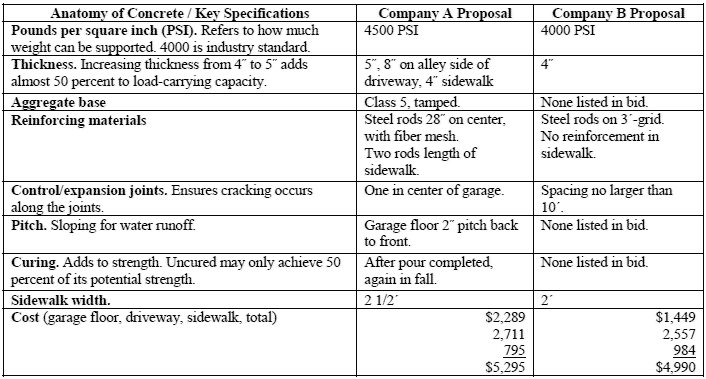Small Home Gazette, Winter 2012
From Teardown to Touch-up
A Bungalow Garage Survives Its Owner’s Remodeling Fever and Gets a New Floor
by Deb McKinley
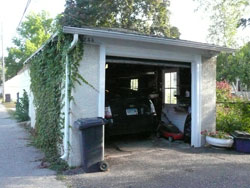 My 1924 single-car garage was sized right when I lived alone. My maneuverability skills were kept sharp—each time I backed the car out into the alley, I had to deftly angle it to avoid the telephone pole at the corner of my parking pad while not clipping the garage door frame. When I married and Pete moved in, I ceded garage-parking rights. His newer car pushed my older car to the curb.
My 1924 single-car garage was sized right when I lived alone. My maneuverability skills were kept sharp—each time I backed the car out into the alley, I had to deftly angle it to avoid the telephone pole at the corner of my parking pad while not clipping the garage door frame. When I married and Pete moved in, I ceded garage-parking rights. His newer car pushed my older car to the curb.
Plans Are Laid
Of the regular woes of on-street parking—which include scraping off snow and ice, and moving for snow emergencies—only one made me crave sheltered parking: the sticky film of “honeydew” (aphid excrement from the overhead tree canopy) coating my entire car in late summer. This annual spray spurred me to look into building a new, two-car garage.

My research started with a visual survey of garages in bungalow neighborhoods. Newer vinyl clad, front gable, no-eave garages were ubiquitous. While functional and cheapest to build, this style of garage received no points when I considered form. I wanted all structures within my 42- by 142-foot estate imbued with the charm of the bungalow era. I liked the look of my single car garage, with its stucco siding, exposed rafter tails, divided-light windows and hipped roof. The roof design, I learned, is well-suited to storm-prone areas as it deflects wind and allows quick runoff.
In 2009, Pete and I met with contractors to scope out a new garage—an A-shaped, stucco, two-car garage with eaves. I learned that for just $25,000, I could keep bug poop off my car. I hesitated, but then proceeded.
Using the dimensions of my neighbor’s two-car garage, I marked off the space my new one would occupy. I dug up my flowerbed; relocating some plants to a trench dug in the lawn outside the construction zone and sharing others with friends. By spring we’d have a new garage. Winter came. I scraped snow and ice off my car windows; I moved it for snow emergencies, all, I noted, without much personal discomfort.
Spring came. I visualized my future, smaller yard. I could see the wall of stucco encroaching, our patch of green space devoured by the bigger garage.
I paused.
The convenience of a larger garage, I realized, did not outweigh my preference for a generous yard. And the old garage was structurally sound. If we didn’t spend $25,000 on a new garage, the money (even after setting aside enough for a lifetime supply of carwashes) would make a nice dent in the cost of a kitchen remodel. My husband shook his head at my new insights and declared permanent rights to the sole garage stall. I expanded my garden bed by 3 feet and used the sod to patch the trench I’d made the previous year for relocated flowers. Our 1924 garage remains, fitting perfectly within our urban estate.
A Concrete Decision
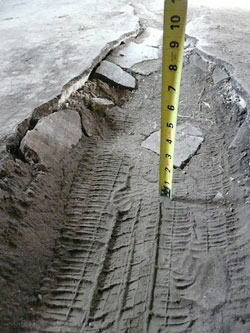
A chasm had opened in the floor.
Two years after not building a new garage, I borrowed my husband’s car for the first time. Returning home and pulling into its rightful place— the garage—I discovered that a 6- by 12-inch chasm had opened in the cement floor. Apparently, Pete had become accustomed to the additional maneuverability challenge of angling the car to keep its front left tire from falling over the edge of the precipice. I deemed it an automotive hazard.
While we didn’t need a new garage, we definitely needed a new garage floor. The 1-inch-thick concrete floor was badly broken in several places. Our back sidewalk also was in need of repair—its concrete squares had heaved and pitched, resulting in puddles and ice ponds that needed bridging every spring thaw.
Contractor Bids
We had contactors bid on a new garage floor, back sidewalk and driveway. We asked each component to be bid separately so we could assess the scope of the project. One company offered a price break for completing all three projects together, reducing the sidewalk replacement to just 30 percent of the bid to do it alone.
Of the three contractors who agreed to come out and bid the project, one was a no show. The other two returned bids with several differences.
With our severe winters, asphalt driveways may outlast concrete ones, plus they can be resurfaced. But we decided to complete all three projects in concrete. With our lightweight vehicles, we weren’t sure we needed the added strength of the more expensive bid. I placed a follow-up call to that contractor, who answered my question using this analogy: “It’s like buying a Cadillac. You’re buying quality.” He also said the 8 inches of concrete along the alley was to support the weight of garbage trucks or other service vehicles that might roll over the edge of the driveway. This Corolla driver decided that we would pay $300 more for greater strength. We’ll see how it holds up over the test of time.
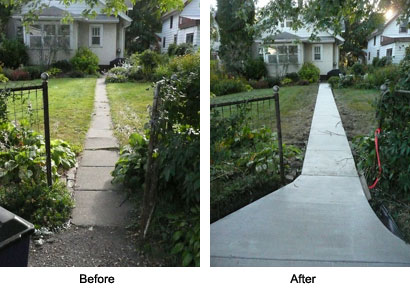 Our existing back sidewalk was 2 feet wide. One contractor spec’d the same width; the other spec’d it half a foot wider. The morning the project was to start, I asked the contractor every question I could think of to be sure I knew what to expect. After discussing how much of my garden beds I had to cede for the wider sidewalk, I decided on a 2-foot walkway instead of 2 1/2. Driving into work, I wondered why the default spec was wider. At the office I looked up the width of a walker and a wheelchair. That’s why!
Our existing back sidewalk was 2 feet wide. One contractor spec’d the same width; the other spec’d it half a foot wider. The morning the project was to start, I asked the contractor every question I could think of to be sure I knew what to expect. After discussing how much of my garden beds I had to cede for the wider sidewalk, I decided on a 2-foot walkway instead of 2 1/2. Driving into work, I wondered why the default spec was wider. At the office I looked up the width of a walker and a wheelchair. That’s why!
These generally have a base width of 24 1/2 to 26 1/2 inches. I called the contractor and requested the 2 1/2-foot width after all.
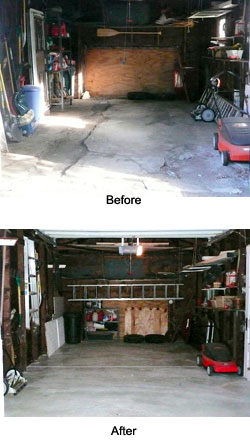 Until we need to accommodate a disability, the extra 6 inches can be an excuse to delay edging the lawn. Another benefit of the work is a better organized garage. To have a new garage floor poured, we had to clear out everything sitting on the ground. This prompted us to get rid of what we didn’t need, rearrange what was left, and add wall hooks for hanging tools.
Until we need to accommodate a disability, the extra 6 inches can be an excuse to delay edging the lawn. Another benefit of the work is a better organized garage. To have a new garage floor poured, we had to clear out everything sitting on the ground. This prompted us to get rid of what we didn’t need, rearrange what was left, and add wall hooks for hanging tools.
Our old garage still stands, amongst new concrete. It looks tidier and feels bigger, if only by a few inches.









